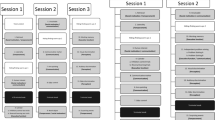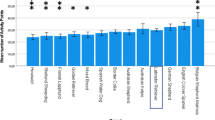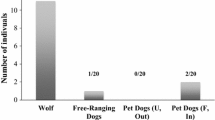Abstract
Both ontogenetic and phylogenetic factors have shaped dogs’ cognitive capabilities, resulting in a heightened social sensitivity at the apparent cost of non-social problem-solving abilities. Research has suggested that training history and life experience can influence problem-solving abilities in dogs. However, the ontogenetic development of problem-solving abilities in dogs has been less explored. We tested a population of candidate detection dogs of various ages across the first year of development on four well-established problem-solving tasks targeting different cognitive domains (i.e., cylinder, A-not-B barrier, delayed search, and spatial transposition tasks). We examined developmental effects by comparing cognitive task performance across three age groups. Age-related improvements for all four cognitive measures indicate developmental increases in processes related to inhibitory control, attention, and spatial cognition between 3 and 12 months of age. Additionally, we found some relationships between cognitive measures and detection dog performance measures, though effects were not as robust. We discuss the results in the context of canine cognitive development and corresponding effects of phylogeny and ontogeny, as well as potential applications to working dog training and selection.





Similar content being viewed by others
References
Barrera G, Alterisio A, Scandurra A, Bentosela M, D’Aniello B (2018) Training improves inhibitory control in water rescue dogs. Anim Cogn. https://doi.org/10.1007/s10071-018-1224-9
Beran MJ (2015) The comparative science of “self-controlâ€: what are we talking about? Front Psychol 6:51. https://doi.org/10.3389/fpsyg.2015.00051
Brady K, Cracknell N, Zulch H, Mills DS (2018) A systematic review of the reliability and validity of behavioural tests used to assess behavioural characteristics important in working dogs. Front Vet Sci 5:103. https://doi.org/10.3389/fvets.2018.00103
Bräuer J, Kaminski J, Riedel J, Call J, Tomasello M (2006) Making inferences about the location of hidden food: social dog, causal ape. J Comp Psychol 120(1):38–47. https://doi.org/10.1037/0735-7036.120.1.38
Bray EE, MacLean EL, Hare BA (2014) Context specificity of inhibitory control in dogs. Anim Cogn 17(1):15–31. https://doi.org/10.1007/s10071-013-0633-z
Bray EE, MacLean EL, Hare BA (2015) Increasing arousal enhances inhibitory control in calm but not excitable dogs. Anim Cogn 18(6):1317–1329. https://doi.org/10.1007/s10071-015-0901-1
Bray EE, Sammel MD, Cheney DL, Serpell JA, Seyfarth RM (2017a) Effects of maternal investment, temperament, and cognition on guide dog success. Proc Natl Acad Sci 113(32):9128–9133. https://doi.org/10.1073/pnas.1704303114
Bray EE, Sammel MD, Seyfarth RM, Serpell JA, Cheney DL (2017b) Temperament and problem solving in a population of adolescent guide dogs. Anim Cogn. https://doi.org/10.1007/s10071-017-1112-8
Brubaker L, Dasgupta S, Bhattacharjee D, Bhadra A, Udell MAR (2017) Differences in problem-solving between canid populations: do domestication and lifetime experience affect persistence? Anim Cogn. https://doi.org/10.1007/s10071-017-1093-7
Brucks D, Marshall-Pescini S, Wallis LJ, Huber L, Range F (2017a) Measures of dogs’ inhibitory control abilities do not correlate across tasks. Front Psychol 8:849. https://doi.org/10.3389/FPSYG.2017.00849
Brucks D, Soliani M, Range F, Marshall-Pescini S (2017b) Reward type and behavioural patterns predict dogs’ success in a delay of gratification paradigm. Sci Rep 7(1):42459. https://doi.org/10.1038/srep42459
Brucks D, Marshall-Pescini S, Range F (2019) Dogs and wolves do not differ in their inhibitory control abilities in a non-social test battery. Anim Cogn 22(1):1–15. https://doi.org/10.1007/s10071-018-1216-9
Cobb M, Branson N, McGreevy P, Lill A, Bennett P (2014) The advent of canine performance science: offering a sustainable future for working dogs. Behav Proc. https://doi.org/10.1016/j.beproc.2014.10.012
Collier-Baker E, Davis JM, Suddendorf T (2004) Do dogs (Canis familiaris) understand invisible displacement? J Comp Psychol 118(4):421–433. https://doi.org/10.1037/0735-7036.118.4.421
Cook PF, Spivak M, Berns G (2016) Neurobehavioral evidence for individual differences in canine cognitive control: an awake fMRI study. Anim Cogn 19(5):867–878. https://doi.org/10.1007/s10071-016-0983-4
Diamond A (1990) Developmental time course in human infants and infant monkeys, and the neural bases of, inhibitory control in reaching. Ann NY Acad Sci 608:637–676. https://doi.org/10.1111/j.1749-6632.1990.tb48913.x
Diamond A, Goldman-Rakic PS (1989) Comparison of human infants and rhesus monkeys on Piaget’s AB task: evidence for dependence on dorsolateral prefrontal cortex. Exp Brain Res 74(1):24–40. https://doi.org/10.1007/BF00248277
Doré FY, Fiset S, Goulet S, Dumas M-C, Gagnon S (1996) Search behavior in cats and dogs: interspecific differences in working memory and spatial cognition. Anim Learn Behav 24(2):142–149. https://doi.org/10.3758/BF03198962
Erdohegyi Á, Topál J, Virányi Z, Miklósi Á (2007) Dog-logic: inferential reasoning in a two-way choice task and its restricted use. Anim Behav 74(4):725–737. https://doi.org/10.1016/j.anbehav.2007.03.004
Fadel FR, Driscoll P, Pilot M, Wright H, Zulch H, Mills D (2016) Differences in trait impulsivity indicate diversification of dog breeds into working and show lines. Sci Rep 6:1–10. https://doi.org/10.1038/srep22162
Fagnani J, Barrera G, Carballo F, Bentosela M (2016) Is previous experience important for inhibitory control? A comparison between shelter and pet dogs in A-not-B and cylinder tasks. Anim Cogn 19(6):1165–1172. https://doi.org/10.1007/s10071-016-1024-z
Fiset S, Plourde V (2013) Object permanence in domestic dogs (Canis lupus familiaris) and gray wolves (Canis lupus). J Comp Psychol 127(2):115–127. https://doi.org/10.1037/a0030595
Fiset S, Gagnon S, Beaulieu C (2000) Spatial encoding of hidden objects in dogs (Canis familiaris). J Comp Psychol 114(4):315–324. https://doi.org/10.1037/0735-7036.114.4.315
Fiset S, Beaulieu C, Landry F (2003) Duration of dogs’ (Canis familiaris) working memory in search for disappearing objects. Anim Cogn 6(1):1–10. https://doi.org/10.1007/s10071-002-0157-4
Fiset S, Pierre NM, Hall NJ (2014) cognitive development in gray wolves: development of object permanence and sensorimotor intelligence with respect to domestic dogs. In: Horowitz A (ed) Domestic dog cognition and behavior: the scientific study of Canis familiaris. Springer, Berlin. https://doi.org/10.1007/978-3-642-53994-7
Gadbois S, Reeve C (2014) Canine olfaction: scent, sign, and situation. Domestic dog cognition and behavior: the scientific study of Canis familiaris. Springer, Berlin. https://doi.org/10.1007/978-3-642-53994-7
Gagnon S, Doré FY (1994) Cross-sectional study of object permanence in domestic puppies (Canis familiaris). J Comp Psychol 108(3):220–232. https://doi.org/10.1037/0735-7036.108.3.220
Gibelli J, Aubin-Horth N, Dubois F (2019) Individual differences in anxiety are related to differences in learning performance and cognitive style. Anim Behav 157:121–128. https://doi.org/10.1016/j.anbehav.2019.09.008
Gross B, Garcia-Tapia D, Riedesel E, Ellinwood NM, Jens J K (2010) Normal canine brain maturation at magnetic resonance imaging. Vet Radiol Ultrasound 51(4): 361–373. https://www.ncbi.nlm.nih.gov/pubmed/20806866
Kabadayi C, Jacobs I, Osvath M (2017a) The development of motor self-regulation in ravens. Front Psychol 8:2100. https://doi.org/10.3389/fpsyg.2017.02100
Kabadayi C, Krasheninnikova A, O’Neill L, van de Weijer J, Osvath M, von Bayern AMP (2017b) Are parrots poor at motor self-regulation or is the cylinder task poor at measuring it? Anim Cogn 20(6):1137–1146. https://doi.org/10.1007/s10071-017-1131-5
Kabadayi C, Bobrowicz K, Osvath M (2018) The detour paradigm in animal cognition. Anim Cogn 21(1):21–35. https://doi.org/10.1007/s10071-017-1152-0
Kelly DM, Adolphe JL, Vernouillet A, McCausland JA, Rankovic A, Verbrugghe A (2019) Motoric self-regulation by sled dogs and pet dogs and the acute effect of carbohydrate source in sled dogs. Anim Cogn. https://doi.org/10.1007/s10071-019-01285-y
Lampe M, Bräuer J, Kaminski J, Virányi Z (2017) The effects of domestication and ontogeny on cognition in dogs and wolves. Sci Rep 7(1):11690. https://doi.org/10.1038/s41598-017-12055-6
Lazarowski L, Haney P, Brock J, Fischer T, Rogers B, Angle C, Waggoner LP (2018) Investigation of the behavioral characteristics of dogs purpose-bred and prepared to perform Vapor Wake® detection of person-borne explosives. Front Vet Sci 5:50. https://doi.org/10.3389/fvets.2018.00050
Lazzaroni M, Range F, Bernasconi L, Darc L, Holtsch M, Massimei R, Marshall-Pescini S (2019) The role of life experience in affecting persistence: a comparative study between free-ranging dogs, pet dogs and captive pack dogs. PLoS ONE 14(4):12–14. https://doi.org/10.1371/journal.pone.0214806
Lea SEG, Osthaus B (2018) In what sense are dogs special? Canine cognition in comparative context. Learn Behav. https://doi.org/10.3758/s13420-018-0349-7
Leighton EA, Hare E, Waggoner LP, Otto CM, Thomas S (2018) A solution for the shortage of detection dogs: a detector dog center of excellence and a cooperative breeding program. Front Vet Sci 5:1–7. https://doi.org/10.3389/fvets.2018.00284
Lit L (2009) Evaluating learning tasks commonly applied in detection dog training. In: Helton WS (ed) Canine ergonomics: the science of working dogs. CRC Press/Taylor and Francis, Boca Raton
Lofgren SE, Wiener P, Blott SC, Sanchez-Molano E, Woolliams JA, Clements DN, Haskell MJ (2014) Management and personality in Labrador Retriever dogs. Appl Anim Behav Sci 156:44–53. https://doi.org/10.1016/J.APPLANIM.2014.04.006
Maclean EL, Hare B, Nunn CL, Addessi E, Amici F, Anderson RC, Zhao Y (2014) The evolution of self-control. Proc Natl Acad Sci. https://doi.org/10.1073/pnas.1323533111
MacLean E, Hare B (2018) Enhanced selection of assistance and explosive detection dogs using cognitive measures. Front Vet Sci 5:236. https://doi.org/10.3389/FVETS.2018.00236
MacLean EL, Herrmann E, Suchindran S, Hare B (2017) Individual differences in cooperative communicative skills are more similar between dogs and humans than chimpanzees. Anim Behav 126:41–51. https://doi.org/10.1016/j.anbehav.2017.01.005
Marshall-Pescini S, Valsecchi P, Petak I, Accorsi PA, Previde EP (2008) Does training make you smarter? The effects of training on dogs’ performance (Canis familiaris) in a problem solving task. Behav Proc 78(3):449–454. https://doi.org/10.1016/j.beproc.2008.02.022
Marshall-Pescini S, Virányi Z, Range F (2015) The effect of domestication on inhibitory control: Wolves and dogs compared. PLoS ONE 10(2):1–16. https://doi.org/10.1371/journal.pone.0118469
Marshall-Pescini S, Rao A, Virányi Z, Range F (2017a) The role of domestication and experience in ‘looking back’ towards humans in an unsolvable task. Sci Rep 7(March):46636. https://doi.org/10.1038/srep46636
Marshall-Pescini S, Virányi Z, Kubinyi E, Range F (2017b) Motivational factors underlying problem solving: Comparing wolf and dog puppies’ explorative and neophobic behaviors at 5, 6, and 8 weeks of age. Front Psychol 8:1–11. https://doi.org/10.3389/fpsyg.2017.00180
Miklósi A (2015) Dog behaviour, evolution, and cognition (2nd ed.) https://catalog.lib.auburn.edu/vufind/Record/3675138
Miller HC, Gipson CD, Vaughan A, Rayburn-Reeves R, Zentall TR (2009) Object permanence in dogs: invisible displacement in a rotation task. Psychon Bull Rev 16(1):150–155. https://doi.org/10.3758/PBR.16.1.150
Mongillo P, Araujo JA, Pitteri E, Carnier P, Adamelli S, Regolin L, Marinelli L (2013) Spatial reversal learning is impaired by age in pet dogs. Age 35(6):2273–2282. https://doi.org/10.1007/s11357-013-9524-0
Müller CA, Riemer S, Virányi Z, Huber L, Range F (2016) Inhibitory control, but not prolonged object-related experience appears to affect physical problem-solving performance of pet dogs. PLoS ONE 11(2):1–19. https://doi.org/10.1371/journal.pone.0147753
Osthaus B, Lea SEG, Slater AM (2003) Training influences problem-solving abilities in dogs (Canis lupus familiaris). Proc Br Soc Anim Sci. https://doi.org/10.1017/S175275620001262X
Osthaus B, Marlow D, Ducat P (2010) Minding the gap: spatial perseveration error in dogs. Anim Cogn 13(6):881–885. https://doi.org/10.1007/s10071-010-0331-z
Reynolds GD, Romano AC (2016) The development of attention systems and working memory in infancy. Front Syst Neurosci 10:15. https://doi.org/10.3389/fnsys.2016.00015
Rooijakkers EF, Kaminski J, Call J (2009) Comparing dogs and great apes in their ability to visually track object transpositions. Anim Cogn 12(6):789–796. https://doi.org/10.1007/s10071-009-0238-8
Rooney NJ, Bradshaw JWS, Almey H (2004) Attributes of specialist search dogs–a questionnaire survey of UK dog handlers and trainers. J Forensic Sci 49(2):300–306. https://doi.org/10.1520/JFS2003048
Shaw RC, Boogert NJ, Clayton NS, Burns KC (2015) Wild psychometrics: evidence for ‘general’ cognitive performance in wild New Zealand robins, Petroica longipes. Anim Behav 109:101–111. https://doi.org/10.1016/j.anbehav.2015.08.001
Tapp PD, Siwak CT, Estrada J, Head E, Muggenburg BA, Cotman CW, Milgram NW (2003) Size and reversal learning in the beagle dog as a measure of executive function and inhibitory control in aging. Learn Mem 10(1):64–73. https://doi.org/10.1101/lm.54403
Tiira K, Tikkanen A, Vainio O (2020) Inhibitory control–important trait for explosive detection performance in police dogs? Appl Anim Behav Sci https://doi.org/10.1016/j.applanim.2020.104942
Topál J, Gergely G, Erdöhegyi Á, Csibra G, Miklósi Á (2009) Differential sensitivity to human communication in dogs, wolves, and human infants. Science 325(5945):1269–1272. https://doi.org/10.1126/science.1176960
Triana E, Pasnak R (1981) Object permanence in cats and dogs. Anim Learn Behav 9(1):135–139. https://doi.org/10.3758/BF03212035
Troisi CA, Mills DS, Wilkinson A, Zulch HE (2019) Behavioral and cognitive factors that affect the success of scent detection dogs. Compar Cognit Behav Rev 14:51–76. https://doi.org/10.3819/ccbr.2019.140007
Udell MAR (2015) When dogs look back : inhibition of independent problem-solving behaviour in domestic dogs (Canis lupus familiaris) compared with wolves (Canis lupus). Biol Lett. https://doi.org/10.1098/rsbl.2015.048
Udell MAR, Dorey NR, Wynne CDL (2010) What did domestication do to dogs? A new account of dogs’ sensitivity to human actions. Biol Rev Camb Philos Soc 85(2):327–345. https://doi.org/10.1111/j.1469-185X.2009.00104.x
van Horik JO, Langley EJG, Whiteside MA, Laker PR, Beardsworth CE, Madden JR (2018) Do detour tasks provide accurate assays of inhibitory control? Proc Biol Sci 285(1875):20180150. https://doi.org/10.1098/rspb.2018.0150
Vernouillet AAA, Stiles LR, Andrew McCausland J, Kelly DM (2018) Individual performance across motoric self-regulation tasks are not correlated for pet dogs. Learn Behav https://doi.org/10.3758/s13420-018-0354-x
Williams BR, Ponesse JS, Schachar RJ, Logan GD, Tannock R (1999) Development of inhibitory control across the life span. Dev Psychol 35(1): 205–213. https://pdfs.semanticscholar.org/595a/c06276f453cbecc5e2bc4ec55308cadee1a2.pdf
Wright HF, Mills DS, Pollux PMJ (2011) Development and validation of a psychometric tool for assessing impulsivity in the domestic dog (Canis familiaris). Int J Compar Psychol 24:210–225. https://doi.org/10.5811/westjem.2011.5.6700
Acknowledgements
This research was supported by Auburn University’s Department of Psychology and the Association of Professional Dog Trainers (APDT) Foundation. We thank Emma Cox, Bart Rogers, and Lily Strassberg for assistance with data collection, and Auburn University’s Canine Performance Sciences for access to the dogs and facilities to perform the experiments.
Author information
Authors and Affiliations
Corresponding author
Ethics declarations
Conflict of interest
The authors declare that they have no conflict of interest.
Ethical standards
This research complied with the current laws of the United States of America and was reviewed and approved by the Institutional Animal Care and Use Committee (IACUC) at Auburn University.
Additional information
Publisher's Note
Springer Nature remains neutral with regard to jurisdictional claims in published maps and institutional affiliations.
Electronic supplementary material
Below is the link to the electronic supplementary material.
Rights and permissions
About this article
Cite this article
Lazarowski, L., Krichbaum, S., Waggoner, L.P. et al. The development of problem-solving abilities in a population of candidate detection dogs (Canis familiaris). Anim Cogn 23, 755–768 (2020). https://doi.org/10.1007/s10071-020-01387-y
Received:
Revised:
Accepted:
Published:
Issue Date:
DOI: https://doi.org/10.1007/s10071-020-01387-y




